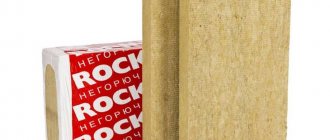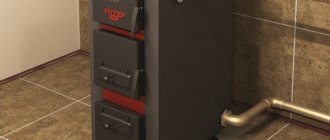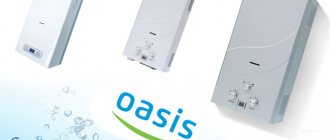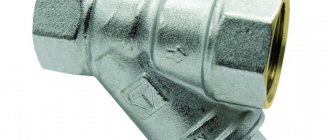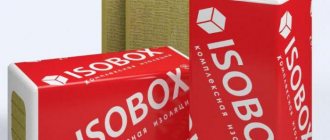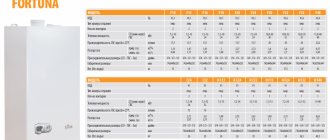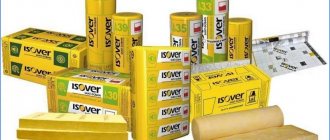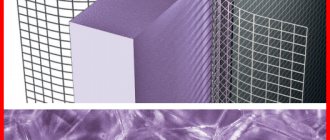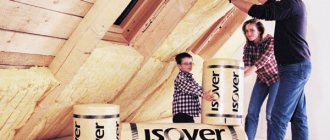In continental climatic conditions, winters are sometimes quite cold. That is why owners of private houses prefer additional insulation of their homes. Special coatings are designed not only for insulating the facade of a house or apartment, but also for ceilings, interior walls, roofing, floor surfaces, and even for saunas and bathhouses. Rockwool insulation is one of the leaders in the market for these products and occupies a leading position in the niche of materials for insulating glass wool facades.
Rockwool Lite BUTS SCANDIC
A little about the company
This trademark was registered in 1936 and correctly appears as ROCKWOOL. The manufacturer insists on writing in Latin letters, without quotation marks, only in capital letters.
The company was founded on the basis of a company registered in Denmark in 1909, engaged in the extraction and sale of coal and rocks. The company also produced roofing tiles.
The first insulation was released in 1936-1937, at which time the name Rockwool was registered. It literally translates as “stone wool”, which accurately reflects the features of thermal insulation materials based on stone wool - they are light and warm, like natural wool, but at the same time strong and durable - just like stone.
Today Rockwool is not just one of the best manufacturers of insulation, but also a company that produces innovative products in its field. This is due to the presence of the company’s own research centers, the developments of which are introduced into production processes.
The production of insulation under this brand is currently established in 18 countries and 28 factories located in them. The company has representative offices in 35 countries. In Russia, the products appeared in the early 70s, initially for the needs of the shipbuilding industry. Due to its high quality, it gradually became widespread in other areas, primarily construction.
The official representative office that appeared in 1995 made the brand even more popular. Today, there are 4 factories in Russia that produce products under the Rockwool brand. They are located in the Leningrad, Moscow, Chelyabinsk regions and the Republic of Tatarstan.
Advantages of a thermal insulator
Rockwool insulation is impregnated with fire retardants, therefore it is completely fireproof.
Rockwool basalt wool successfully competes with the best examples of organic insulation. Compared to them, it has the following advantages:
- environmental cleanliness of the raw materials themselves and the entire process of processing and manufacturing the final product;
- good thermal conductivity;
- minimizing binders harmful to humans;
- excellent sound-absorbing properties;
- waterproofing, defined as hydrophobicity;
- impossibility of reproduction of parasitic microflora, rodents and harmful insects.
One of the key advantages of the material is fire safety, the level of which it surpasses well-known synthetic analogues.
Peculiarities
One of the distinctive features of the material is its environmental friendliness, which is confirmed by the presence of certificates of product compliance with EcoMaterial standards. In addition, in 2013, the manufacturer became the owner of the Ecomaterial 1.3 certificate, indicating that the company's production activities are environmentally friendly. The safety class of these materials is KM0, which means they are absolutely harmless.
The manufacturer’s concept is to create energy-efficient buildings, that is, objects characterized by an improved microclimate and energy savings of up to 70-90%. Within the framework of this concept, a material with the lowest possible thermal conductivity is selected, and many insulation options are developed for specific surfaces, types of objects and areas of the same building.
In terms of its thermal conductivity, basalt slab insulation of the brand in question is ahead of similar products from many European manufacturers. Its value is 0.036-0.038 W/mK.
In addition to high thermal insulation properties, the materials of this brand serve for sound insulation.
Thanks to high sound insulation coefficients, it is possible to reduce the impact of airborne noise to 43-62 dB, impact noise to 38 dB.
Thanks to special hydrophobic treatment, Rockwool basalt insulation is moisture resistant. It does not absorb moisture, which significantly extends its service life and increases frost resistance, and also guarantees the biostability of products.
Basalt insulation of this brand is characterized by excellent vapor permeability, which allows you to maintain an optimal microclimate in the room, as well as avoid the formation of condensation on the surface of walls or materials used for insulation and finishing.
Rockwool insulation has a fire safety class of NG, which means it is completely non-flammable. This allows the slabs to be used not only as thermal insulation, but also as a fire barrier material. Some types of insulation (for example, reinforced with a foil layer) have a flammability class of G1. In any case, when heated, the product does not release toxins.
The specified technical characteristics ensure the durability of thermal insulation products, the service life of which is 50 years.
Summary
The fundamental differences in mineral insulation are insignificant. The emphasis on properties is justified only in product advertising:
- Paroc – all elastic;
- Izovol for a bath - with a reinforced heat-reflecting layer;
- blow-in cotton wool Isover – penetrates into any nooks and crannies;
- Ursa Pureone – thanks to a natural binder, it is environmentally friendly.
But the cost may vary significantly. The situation is complicated by the different values of measures in the price lists.
In this review, prices are reduced to a single indicator (RUB/m³). Therefore, just choose the most profitable option for the current period.
And remember: in the case of mineral wool, it is not the price that heats, but the volume.
The main advantages of basalt insulation of the ROCKWOOL brand
It would seem, what is the connection between the cold structure of the stone and insulation? Surely, the principle was “seen” from nature itself. During volcanic eruptions, molten rocks form lava flows, which, when solidified under the influence of wind, can create the finest, but surprisingly strong mineral fibers. It is this phenomenon that is used in the basic technology for the production of stone wool.
The raw materials are seemingly unremarkable rocks of the basalt group. These minerals are very common all over the world; their extraction, as a rule, is not difficult and not particularly expensive, since it is produced by an open method, so there is no shortage of starting material.
Inconspicuous-looking stones are the raw material for the production of basalt wool
After preliminary preparation, the raw material is loaded into furnaces, where, under the influence of temperatures of about 1500 ° C, it turns into a liquid molten mass. This melt enters special centrifuges, is sprayed into tiny jets and solidifies in the form of thin and long fibers (the fiber diameter usually does not exceed 15 microns, and the length is up to 50 mm).
Fibrous structure of basalt insulation
The frozen fibers are first collected into a kind of “carpet”, which is treated with special binders and hydrophobic compounds. Then there are pressing stages to give the material the necessary density parameters, the resulting mats undergo additional temperature treatment, and at the end of the production cycle they are cut into blocks of standard sizes for further transfer to the packaging line.
The result is blocks of the required size and density, consisting of chaotically located finest basalt fibers, in the interweaving of which a huge number of air-filled cavities are created. Such a structure, saturated with immobilized air, in principle, determines the highest thermal insulation characteristics of the finished mineral wool.
In terms of its insulating qualities, ROCKWOOL basalt wool successfully competes even with the most modern organic-based thermal insulation materials, but at the same time it has a whole range of undeniable advantages.
- First of all, this is the already mentioned environmental cleanliness of the raw materials, the process of its processing and the resulting products. It may be argued that the technological chain still involves the processing of fibers with binders based on formaldehyde resins. However, their content is negligible, and in addition, during the final heat treatment of mineral wool, almost complete polymerization of these substances occurs, and they are unable to give off fumes that pose any threat to human health. It is not for nothing that ROCKWOOL products have been awarded certificates confirming compliance with the most stringent sanitary standards - insulation materials are suitable for use in all types of residential and public premises, including children's and medical institutions.
- ROCKWOOL mineral basalt wool is not only an excellent insulation material, but also a very effective barrier against the spread of airborne and impact noise. Thus, with proper installation of a soundproofing system, it is possible to reduce external airborne noise from 43 to 62 dB, and impact noise by up to 38 dB.
An important advantage of the material is hydrophobicity. Drops of water roll down it
- Basalt rock itself is a “non-wet” structure that does not absorb moisture, and the special treatment of ROCKWOOL slabs also provides them with pronounced hydrophobic qualities. The material is not saturated with water, which means it does not lose its insulating qualities, and favorable conditions for the development of microbiological life forms are not created in it. And the natural mineral base of basalt wool will not become a breeding ground for parasitic microflora, insects or rodents. The processes of biological decomposition, decay, and rotting are not at all typical for basalt fibers. By the way, even basalt insulation that has served a long time is quite suitable for recycling - the material does not lose its qualities at all over time.
- Hydrophobicity does not mean that water vapor cannot pass through the structure of the material. On the contrary, the vapor permeability of ROCKWOOL slabs is excellent, which is extremely important for maintaining normal temperature and humidity balance in insulated buildings. It is usually said about such materials that they allow the house to “breathe”.
ROCKWOOL slabs allow water vapor to pass freely - the walls remain “breathable”
- One of the key qualities is the fire safety of the material. Whatever they say about synthetic insulation, none of them can be called absolutely safe from the point of view of fire and the release of extremely toxic combustion products. And if technologists are struggling to give their synthetic materials fire safety classes KM1 or KM2 (which is already considered a good achievement), then with ROCKWOOL insulation the “verdict” is clear: safety class KM0 (absolutely safe), and flammability group - NG, that is non-flammable. It is not without reason that such slabs are used not only for thermal insulation work, but also to create effective fire barriers.
- The random arrangement of fibers not only determines the high thermal and sound insulation characteristics of the material - it ensures the durability of the insulation, which does not shrink at all even in unfavorable operating conditions. This means that over time no gaps or voids will form, and the original qualities of the insulating structure will remain at the same level throughout the entire period of use. And the service life of ROCKWOOL insulation without loss of any properties, subject to installation technology, is estimated at at least 50 years.
In addition, the clear “geometry” of ROCKWOOL insulation materials makes their installation extremely convenient. Basalt slabs are easily cut to the required size, but do not lose their shape, do not delaminate or crumble. At the same time, they are elastic and resilient enough to make it possible to insulate even building structures with complex configurations.
- Unlike other mineral fiber insulation, basalt wool does not cause significant irritation to the skin and mucous membranes, and working with it is much safer and more convenient. True, compliance with certain requirements is still necessary.
These advantages of ROCKWOOL basalt insulation determine their widespread use in residential construction:
The use of ROCKWOOL slabs in the construction and insulation of a private house
1 – insulation of external walls of a variety of structures (frame, wooden, solid) and using various technologies – multi-layer installation, ventilated “wet” plastered facade, etc. This also includes thermal insulation of the basement part of the facade.
If certain requirements are met, it is possible to insulate the walls on the inside of the house.
2 – construction of internal partitions in the house, giving them high sound and thermal insulation characteristics.
3 – insulation of floors of any design, including those with poured screeds and ceilings.
4 – thermal insulation of the roof, including both pitched and flat roofs of almost any design. Insulation of attic (attic) rooms.
For all the listed works, the ROCKWOOL product range includes both universal materials and those with pronounced specific properties - for specific elements of the building.
Varieties and properties
Now let's turn directly to the types of mineral wool. For insulation of such properties and sizes, there are most often only two main forms of execution:
Rolls; Plates. Mineral wool insulation is not produced in rolls very often, since it is convenient to work with rolls only when insulating floors or attics. It is especially convenient to use them for finishing unused attics, where the roll can be simply laid out.
In all other cases, it is more appropriate to buy slabs. The peculiarity of the mineral wool board is its effectiveness. The slabs are produced in acceptable sizes with a certain thickness. They are easy to install, solid and quick to process.
In addition, you can even lay slabs on ceilings yourself, without the help of partners. Actually, this is what almost all reviews from customers indicate.
Division into types by area of application
The Rockwool company produces insulation materials in huge quantities. Moreover, the scope of their application is divided into all main types of construction work.
That is, almost everything can be insulated. From the roof to the partitions or floor.
The main groups of Rockwool insulation concentrate on the following areas. Finish:
Flat and pitched roofs; Facades; Internal walls and partitions; Flooring (Venti Butts Rockwool); Arrangement of sound insulation and other additional works.
Rockwool for roofing
For roofing, the Rockwool company offers its customers Roof and Light Butts slabs. These are special plates of a special type that were developed for specific tasks.
Insulation of pitched roofs with Light Butts slabs
Light Butts samples have low density and high compression ratio. They are easy to install between the rafters and generally wherever it is convenient for you. This insulation is largely universal.
Ruf Butts models are the complete opposite. These are moderately heavy, extremely dense slabs that can withstand enormous loads. They are designed for treating both unused and used roofs.
Rockwool for facades
For facades, individual models from the Light Butts line are also often used. However, here the main load is taken by the Venti Butts line, which is intended for arranging ventilated facades.
Rockwool for walls and partitions
In the target area, basalt insulation slabs are also used. Only here the main priority falls on the light batts Scandic insulation, which is almost ideally suited for the given work.
To insulate partitions and create full-fledged dividing lines, Rockwool Acoustic is used. Plates of this type are known for their ability to dampen noise well from external influences, so they do an excellent job of forming separate partitions.
Moreover, these partitions are full-fledged; with their help, you can divide large rooms into small ones, while isolating them both from the point of view of the banal division of space, and from the point of view of noise emissions.
Rockwool for floors
On the floors you can use the same universal Rockwool Light Butts. In particular, it is perfect for installation under joists. Only in this case the logs will need to be properly secured and sheathed with boards.
The most popular thermal insulation material is Rockwool Light Butts Scandic
Insulation of a bath or sauna
Thermal insulation of a bathhouse or sauna requires a completely special approach. Here it is necessary to simultaneously solve two problems at once - to ensure heat conservation and to prevent the destructive effect of high humidity on the insulation itself and on the wall structure. All this can be solved by using special plates - ROCKWOOL SAUNA BUTTS.
A very special type of insulation boards - ROCKWOOL SAUNA BUTTS
These plates have a foil surface on one side. A thin aluminum layer becomes a reliable barrier to water vapor, and in addition, it actively reflects thermal energy back into the room, creating the most favorable conditions for bath procedures.
Foil surface of slabs for insulation of baths
This material can be used for any surfaces in the bathhouse - for external walls, for internal partitions and for wall ceilings. As a result, the steam room becomes a kind of “thermos”, which will retain heat for a very long time.
A typical thermal insulation scheme for steam room walls is shown in the figure:
Approximate scheme for insulating a steam room
1 – internal partition separating the steam room from the dressing room. Excessive thermal insulation is not required here - one layer of SAUNA BATTS slabs (item 3) laid between the drains of the wall frame structure (item 2) is sufficient.
The external wall (item 6) will require better insulation, so a two-layer structure is used here. Adjacent to the outer wall is a layer of universal ROCKWOOL LIGHT BUTTS SCANDIC or ROCKWOOL LIGHT BUTTS slabs (item 7). And on top of it a layer of SAUNA BUTTS is already laid out.
All gaps between the slabs vertically and horizontally (item 4) are sealed with special aluminized ROCKWOOL tape. The task is to achieve complete sealing of the vapor barrier and reflective surface, leaving no “loops” for moisture to penetrate into the insulation.
Aluminum tape achieves maximum sealing of the foil insulation layer
Aluminum adhesive tape ROCKWOOL is available in rolls of 40 m, width 50 or 100 mm. The adhesive layer made of synthetic rubber ensures reliable fixation of the tape even in conditions of high humidity.
After this, the sheathing slats are installed (item 5), along which, leaving a small ventilation gap, the wooden lining of the steam room is installed (item 8).
The parameters of ROCKWOOL SAUNA BUTTS are given in the table:
| Name of characteristics | Indicators |
| Material density, kg/m³ | 40 |
| Thermal conductivity coefficient, W/m×°С | 0,036 |
| Flammability group | G1 |
| Fire safety class | KM1 |
| Permissible temperature of use | up to + 200 °C |
| Slab dimensions, mm: | |
| - lenght and width | 1000 ×600 |
| - slab thickness | 50 or 100 mm |
Video: how to insulate a sauna with ROCKWOOL slabs SAUNA BUTTS
So, the main types of insulation boards and related materials used for thermal insulation work in a private home were considered. The list of ROCKWOOL products is by no means limited to this. Many types of special thermal insulation are produced, for example, for process equipment and pipelines, materials for fire protection and for creating sound-proof structures. But these are topics for separate consideration.
Rockwool technical specifications
Rockwool Butts insulation has high performance characteristics, which once again confirms its popularity among thermal insulation boards.
Technical characteristics of Rockwool
In addition, all products are manufactured using special technologies and have an EcoMaterialGreen quality certificate, which confirms complete environmental friendliness and safety.
Advantages
Thermal insulation with this material has its significant advantages:
- the slabs do not form gaps and cracks due to the increased density during installation;
- reliably protects against the formation of mold, mildew, and rodents due to its high biostability;
- non-flammability of the material;
- moisture resistance;
- high sound and heat insulation;
- springy base, which is obtained as a result of the unique “flexi” technology, which makes installation quite easy and quick.
Scope of application
Light Butts are modern construction pressed slabs made from stone wool. It is obtained by processing basalt rocks, which makes the material strong and resistant to various damages and impacts. So, the scope of their application is quite diverse:
- building's facade;
- interior walls;
- interior partitions, balconies, loggias, attic;
- roof;
- floor coverings;
- entrance doors, garage doors;
- external and internal walls of the apartment.
Rockwool insulation, due to its technical characteristics, has a wide range of applications.
Specification and Dimensions
The manufacturer produces products in two types:
- standard – 60x80 cm (thickness – 5 or 10 cm) – this size is convenient for transportation by car;
- XL – 60x120 cm (thickness – 10 and 15 cm) – in case of transportation by truck.
To roughly understand how much space one package occupies and to facilitate the process of loading and delivering material, you can use the table:
Rockwool insulation size
Scope of application
- Thermal insulation materials Rockwool are widely used in construction, in particular, for insulating the external walls of buildings. With the help of insulation materials, it is possible to increase the thermal efficiency of wooden, reinforced concrete, stone, brick walls, facades made of foam blocks, as well as prefabricated panel structures.
- By choosing one or another type of insulation and other materials, it is possible to build “dry” and “wet”, as well as ventilated and unventilated facade systems. When insulating a frame house, it is enough to use mats of increased rigidity so that they play the role of not only insulation, but also a load-bearing function.
- It is basalt insulation that has become most widespread when insulating rooms from the inside. They are used for heat and sound insulation of walls, partitions, floors of any design, and ceilings.
- The material is in great demand for roofing work. It is suitable for thermal insulation of pitched and roofing roofs, attics and attics. Due to its fire resistance and wide operating temperature range, the material is suitable for thermal insulation and thermal protection of stove pipes, chimneys, and air ducts.
- Special heat-insulating cylinders based on stone wool are used for insulation of pipelines, heating networks, sewer and water supply systems.
- Plates of increased rigidity are used for insulating facades, inside wall “wells” in a three-layer facade system, under floor screed, and also as an interfloor thermal insulation layer.
Installation work
Insulation of the façade of a home with mineral wool begins from the bottom of the wall and is carried out on a pre-installed profile. For fixation, 2 methods can be used, recommended to be carried out in a comprehensive manner:
- adhesive, during which the slabs are fixed to the coating using special compounds (to obtain better results, it is recommended to use Rockglue);
- use of dowels with large locking washers.
Glue is applied to the covering of the mini-slab in a layer of 0.3-0.4 cm with a notched special spatula, then the slab is pressed against the wall, and after 2 days it is possible to begin fixing it with dowels.
Installation of mini-slabs
The reinforcement of the insulation is carried out at the same time as the fastening of the mini-slabs using dowels. For reliable fastening, in addition to anchors, special putty is used, which must be treated with a primer after drying.
The final stage in the installation of Light Butts mini-slabs will be plastering work using facade insulation under the plaster. Often in such situations, decorative facade plasters are chosen, applied in a thin layer. This will help eliminate additional load, add strength, increase service life, and provide greater color and texture possibilities when creating the architectural style of a home.
To improve the sound and heat insulation parameters in a home, there are a large number of methods and materials. However, one of the most effective and comfortable is considered to be facade insulation using Light Butts mini-slabs
Before starting work, it is important to familiarize yourself with the step-by-step guide and technical parameters of the material
Dimensions
Materials for different applications have different dimensions. In addition, within one line there are several size modifications.
- Light Butts slabs are available in sizes 1000x600 mm with a thickness of 50 or 100 mm. Standard dimensions of “Light Butts Scandic” are 8000×600 mm, thickness is 50 and 100 mm. There is also a version of the material “Light Butts Scandic XL”, characterized by a larger slab size - 1200x600 mm with a thickness of 100 and 150 mm.
- The materials "Venti Butts" and "Optima" have the same dimensions and are available in 2 sizes - 1000x600 mm and 1200x1000 mm. Venti Butts N slabs are produced only in sizes 1000x600 mm. The material “Venti Butts D” has the largest number of dimensional options – 1000×600 mm, 1200×1000 mm, 1200×1200 mm. Material thickness (depending on type) – 30-200 mm.
- The dimensions of the slabs for a three-layer facade are the same and equal to 1000 × 600 mm. The only difference is the possible thickness. The maximum thickness of Cavity Butts is 200 mm, Concrete Element Butts is 180 mm. The minimum thickness is identical and equal to 50 mm.
- Almost all types of slabs for “wet” facades are available in several size variations. The exception is “Rockfacade” and “Plaster Butts”, which have dimensions of 1000x600 mm with a thickness of 50-100 mm and 50-200 mm.
- 3 dimensional modifications (1000×600 mm, 1200×1000 mm and 1200×1200 mm) have the products “Facade Butts Optima” and “Facade Butts D”.
- There are also 3 size options, but different ones have “Facade Butts” slabs (1200×500 mm, 1200×600 mm and 1000×600 mm). The thickness of the product ranges from 25 to 180 mm. “Lamella façade” has a standard length of 1200 mm and a width of 150 and 200 mm. The thickness ranges from 50-200 mm.
- The dimensions of the materials for thermal insulation of the floor in the screed are the same for both modifications and are equal to 1000 × 600 mm, the thickness ranges from 25 to 200 mm.
- All materials for flat roofing are available in 4 sizes - 2400×1200 mm, 2000×1200 mm, 1200×1000 mm, 1000×600 mm. The thickness is 40-200 mm. “Sauna Butts” is produced in the form of slabs 1000x600 mm, in 2 thicknesses - 50 and 100 mm.
Lite Batts
Peculiarities
As I said above, the manufacturer does not recommend using Floor Batts for wall insulation.
For these purposes, there is a special material Light Butts. It consists of lightweight mineral wool slabs. The main difference between this brand and Floor Butts is its lower density - 37 kg/m3. In addition, the Light Butts material has another unique feature - flexi technology.
Flexi technology ensures easy installation of slabs and their tight fit to the frame
The meaning of this technology is that on one side the plate is springy. This greatly simplifies the installation of the slabs into the frame with your own hands, and also ensures their tight fit to the frame posts.
Light slabs are lightweight
Otherwise, the material is made of the same basalt fibers as the floor slabs. Therefore, it has the same characteristics, including thermal conductivity, vapor permeability and moisture resistance.
The only thing is that, unlike floor slabs, wall slabs cannot withstand loads. As a result, they can only be used in frame structures. Moreover, in the case of insulation of frame walls, their height should not exceed three meters, otherwise jumpers must be installed.
Varieties
There are three modifications of Light Butts on sale, which have minor differences from each other:
Light (basic). A universal material that can be used both for internal wall insulation and external insulation in ventilated facade systems. In addition, this insulation is suitable for insulating frame walls, pitched roofs, partitions and floors on joists;
Light Scandic slabs are compressed in packaging, which simplifies their transportation
Light Scandic. The main feature of this series is that the slabs in the package are compressed by 60%. This allows you to reduce transportation costs. After the packaging is unsealed, the slabs regain their original volume. The characteristics of the material, as well as the scope of application, are the same as those of Light Bats;
Light Extra slabs are characterized by increased density and strength
Light EXTRA. The peculiarity of this brand is its increased strength due to increased density up to 40-50 kg/m³. At the same time, the thermal conductivity is the same as that of other plates of the Butts series. The scope of application is also no different, the only thing is that the manufacturer separately highlights the possibility of using slabs in three-layer walls made of brick or other piece materials.
The photo shows Acoustic Butts slabs - they are distinguished by improved sound insulation qualities
How to calculate thermal insulation parameters?
Calculating thermal insulation parameters is always a difficult process for a non-professional. When choosing the thickness of the insulation, it is important to take into account many criteria - wall material, climatic characteristics of the region, type of finishing material, features of the purpose and design of the area used.
There are special formulas for calculations; you can’t do without SNiPs. Leading manufacturers of thermal insulation materials have significantly simplified the process of determining thermal insulation parameters by creating special formulas.
One of the best formulas belongs to the Rockwool company. You can use it by indicating in the appropriate columns of the online calculator the type of work, the material of the insulated surface and its thickness, as well as the desired type of insulation. The program will produce the finished result in a matter of seconds.
To determine the required volumes of the heat insulator, you should calculate the area to be insulated (multiply the length and width). Once you know the area, it is easier to choose the optimal size of insulation, as well as calculate the number of mats or slabs. To insulate flat horizontal surfaces, it is more convenient to use roll modifications.
Insulation is usually purchased with a small, up to 5%, reserve in case of damage to the material and taking into account its cutting and filling the seams between the elements of the heat-insulating layer (the joints of 2 adjacent slabs).
Knauf (Stupino, Tyumen)
Knauf
Each of the thermal insulation options in the innovative Knauf Insulation line is designed to solve specific problems:
- Knauf Insulation Facade - for insulating walls under ventilated facades and plaster.
- Knauf Insulation Pitched Roof - for thermal insulation of pitched roofs and attic floors.
- Knauf Insulation Acoustic Partition – for effective sound absorption.
High profitability with this material is possible when insulating large areas, such as production or retail sites. When building a private house and apartment, you will pay a little more than for conventional material, but you will receive reliably insulated surfaces.
Pros - declared environmental friendliness, due to the absence of a phenol-formaldehyde binder and packaging (a single package reduces the volume of material by half, a multipack - 8 times).
The downside is the modest size range and price.
Main characteristics of Knauf Insulation
| Knauf Insulation Facade Thermo Plate 032A | Knauf Insulation Pitched Roof Thermo Roll 037 | Knauf Insulation Acoustic Partition | |
| Purpose | Thermal insulation of ventilated facades | Reducing heat loss in the attic floor | Soundproofing rooms |
| Dimensions, mm | 1 250x600x100 | 9 000х1 200х50 | 1 250x610x50 |
| Density, kg/m³ | 34 | 25 | 15 |
| Thermal conductivity, W/(m K) | 0.032 | 0.041 | 0.37 |
| Quantity per package(pieces/m²/m³) | 5 / 3.75 / 0.375 | 2/ 12.2 / 0.61 | 24 / 18.3 / 0.915 |
| Price, rub/m³ | 2 133 | 1 388 | 1 282 |
Review of Knauf insulation. The author of the video showed what happened to the insulation after it was set on fire and rolled with a forklift:
https://youtube.com/watch?v=mq7Hi_1nSgI
Tips and tricks
When choosing a particular insulation, the manufacturer recommends paying attention to its density and purpose.
In addition to thermal insulation materials, the company produces waterproofing films and vapor barrier membranes. The manufacturer's recommendations and user reviews allow us to conclude that for Rockwool insulation it is better to use films and coatings from the same manufacturer. This allows for maximum compatibility of materials.
Thus, for wall insulation (Lite and Scandic) a diffuse vapor-permeable membrane is provided in regular and fire-retardant-treated versions. Special Rockwool vapor barrier is used to insulate roofs and ceilings.
When organizing a “wet” facade, you will need a special water-dispersed primer “Rockforce” , as well as “Rockglue” glue and “Rockmortar” adhesive to create a reinforcing layer. It is recommended to apply the final primer over the reinforcing layer using the Rockprimer KR mixture. As a decorative mixture, you can use the branded products “Rockdecor” (plaster) and “Rocksil” (silicone paint for facades).
To learn how to insulate a house yourself using Rockwool materials, see below.
Frame wall insulation technology
The basis of the house is a wooden frame, sheathed on both sides with sheet material. Between them are thermal insulation boards. Rockwool Light Butts and Rockwool Light Butts Santik are optimal for the job.
Useful: Insulation for the floor of a frame house
Wall pie laying diagram:
- installation of a vapor barrier membrane on the inside of the room;
- placement of insulation;
- wind protection fastening;
- outer skin.
The whole process consists of the four stages outlined above. Detailed instructions:
- Vapor barrier. Apply adhesive tape to the inside of the frame posts, remove the protective film and attach the membrane with an overlap of 10 cm. Additionally, secure the sheets with a stapler and glue the joints with tape .
- Laying mineral wool. Cut the insulation according to the size of the cells between the frame posts. Install heat-insulating mats, and, if necessary, install a second layer of mineral wool.
- Wind barrier installation. The membrane is attached in the same way as a vapor barrier - on adhesive tape and fixed with a stapler .
- Sheathing. To install sheet material, you need to fill the sheathing with 20*30 mm slats. Attach OSB sheets over the planks, leaving a gap of 3-5 mm between the sheets.
